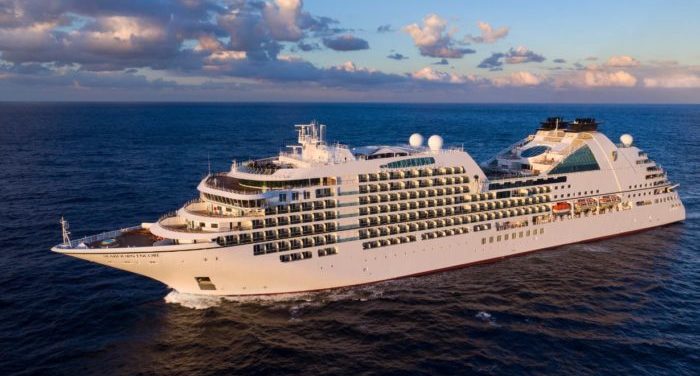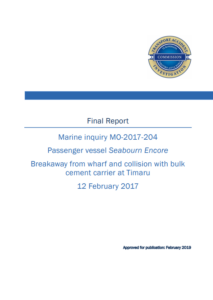New Zealand’s Transport Accident Investigation Committee (TAIC) issued an investigation report on the collision of the passenger ship ‘Seabourn Encore’ with the bulk cement carrier at Timaru, on 12 February 2017, after its breakaway from wharf. The Commission found that the mooring failed because the bollards on the wharf failed.
The incident
The cruise ship Seabourn Encore was moored at the Port of Timaru. During the day, the wind grew stronger, changed direction quicker and earlier than predicted. It pushed the ship away from the wharf, and The ship’s mooring lines progressively failed, as did the mooring bollards on the wharf, which tore away from the wharf.
The ship’s stern swung across the harbour and collided with a bulk cement ship. The Seabourn Encore crew’s prompt action (establishing power to propulsion systems, lessening the impact and maintaining control of the ship) very likely reduced the consequences of the accident.
There was damage to the Seaborne Encore’s wharf and the hulls of both ships. Neither ship’s stability was affected. Nobody was injured.
Key findings
- The Commission found that the mooring failed because the bollards on the wharf failed. The bollards failed because their fastenings to the wharf, and the underlying wharf structure, could not take the force from the ship’s mooring lines.
- The Commission also found that the port company did not know enough about the safe working loads of the bollards on the wharf and the port’s mooring procedures were not strictly followed.
- The port company didn’t follow its own plan for responding to a predicted change in the weather.
- As a result, neither port staff nor ship’s crew could get ready in time. In the event, prompt action by the ship’s crew very likely reduced the consequences of the accident.
Lessons learned
- Bollard strength: The safe working loads of the bollards on the wharf were unknown so it was not possible to determine whether the mooring plan for any ship was safe. Port companies must know the safe working loads for their mooring infrastructure in order to produce safe and effective ship mooring plans.
- Mooring procedures: The port’s mooring procedures were not strictly adhered to and the procedure in the event of a high wind warning was ineffective. Procedures for monitoring and communicating weather conditions must be robust and strictly followed when harbouring ships that are prone to high winds.
Recommendations
Following investigation, TAIC recommended:
- In Timaru: PrimePort Timaru is assessing risks for vessels intending to use the port. This includes identifying: whether berth are safe for vessels to be remain alongside; operational limits, and any additional measures needed.
- Nationwide: Maritime NZ has committed to publicise the report’s findings to harbourmasters and port operators, particularly risks associated with securing large vessels that may exert unexpectedly heavy loads on port infrastructure.
Explore more herebelow:





























































